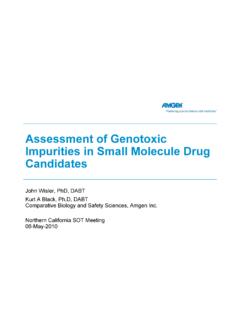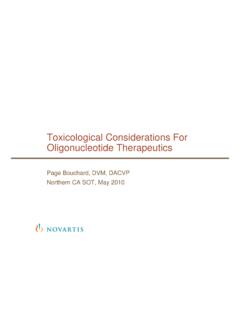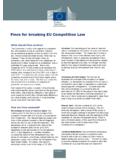Transcription of An Update on FDA’s Good Laboratory Practice
1 An Update on FDA s Good Laboratory Practice (GLP) for Nonclinical Laboratory Studies Proposed Rule SOT: Regulatory and Safety Evaluation Specialty Section Webinar September 29, 2017 Mark Seaton, , DABT, FDA/CDER/OTS/OSIS 2 Disclaimer The views expressed in this presentation are those of the speaker, and do not necessarily reflect the official views of the Food and Drug Administration (FDA) 3 GLP for Nonclinical Laboratory Studies Proposed Rule Outline A Brief History of GLP Regulations Background for Notice of Proposed Rulemaking (NPRM) Highlights of Proposed Changes 4 A BRIEF HISTORY OF GLP REGULATIONS Good Laboratory Practice (GLP) for Nonclinical Laboratory Studies Proposed Rule 5 GLPs: How did we get here? Printed in Collier's magazine, 11 articles in 1905, by Samuel Hopkins Adams on fraud in the pharmaceutical industry. The publication so outraged the public that Congress was finally able to enact the first of several pure food and drug laws in 1906.
2 In the 1920's the Food & Drug Administration was established to regulate the Nation's food and drug industry. 6 History 1900 s Pure Food and Drug Act, 1906 Banned foreign and interstate traffic in adulterated or mislabeled food and drug products. Directed the Bureau of Chemistry to inspect products and refer offenders to prosecutors. Required that active ingredients be placed on the label of a drug s packaging and that drugs could not fall below purity levels. Drug labels had to list any of 10 ingredients that were deemed "addictive" and/or "dangerous" on the product label if they were present, including alcohol, morphine, opium, cannabis. Did not require safety or efficacy testing. 7 Federal Food, Drug & Cosmetic Act, 1938 Gave FDA authority to oversee the safety of food, drugs and cosmetics. Included cosmetics and medical devices. Required drugs be labeled with adequate directions for safe use.
3 Prohibited false therapeutic claims for drugs. Mandated pre-market approval of all new drugs, including proving safety. History 1930 s 8 History 1960 s 1962, Silent Spring by Rachel Carson detailed the negative impact on the environment of indiscriminate pesticide use. 1970, Formation of EPA Requirement for more safety testing studies and more labs in which to conduct those studies. 9 Industrial Bio-Test Laboratories (IBT) 1975, FDA received a tip that there were problems with tests submitted to FDA. The medical officer found study data was unbelievably clean , no rats on 2 year study developed cancer. The medical officer found enough deficiencies to warrant an inspection. Visit to IBT in April 1976: What we found there is enough to make your hair stand up . 10 Magic Pencil Study Terminal blood and urine samples were not collected. Draft data tables for the blood and urine assessments were blank, as expected.
4 However, the final report not only had values reported, but had the technical writer s name written in. All of those results had been fabricated. 11 The Swamp System designed for automatic watering and flushing waste from cages rarely worked properly. Faulty nozzles sprayed the room with a continuing mist. The floor was at times submerged under 4 inches of water. Technicians only entered the room wearing rubber boots. Clogged water nozzles and drain hoses drenched some rats in a cold spray, while others died of thirst. 12 Regulatory Action FDA and EPA reviewed compounds that relied on IBT for data in support of safety. Called into question the reviews of more than 200 pesticides, many were retested at manufacturer s expense. 618 of 867 (71%) of studies audited by the FDA were invalidated for having "numerous discrepancies between the study conduct and data . 13 Congress proposed and enacted the Good Laboratory Practice Regulations for FDA as part of the Federal Food, Drug, and Cosmetic Act (FD&C).
5 21 CFR Part 58 Good Laboratory Practices For Nonclinical Studies The proposed regulations for Good Laboratory Practice were published in the Federal Register on November 19, 1976. The Good Laboratory Practice Regulations, Final Rule was published in the Federal Register on December 22, 1978. HISTORY -1970 s 14 History 1980s Federal Register of October 29, 1984 (49 FR 43530), FDA published a proposal to amend the agency's regulations in 21 CFR Part 58. 33 commenters. Revised Good Laboratory Practice Regulations, Final Rule was published in the Federal Register on September 4, 1987. Significant changes in the provisions with respect to quality assurance, protocol preparation, test and control article characterization, and retention of specimens and samples 15 History 2000 s 2003, Coulston Foundation was disqualified by the FDA TFM and QAU deficiencies Study records deficiencies Warning letters December 22, 1999 and October 11, 2001 led to consent agreement Notice of Opportunity for a Hearing letter March 18, 2003 16 Primary References Faking It, The Case Against Industrial Bio-Test Laboratories, The Amicus Journal, Spring 1983 Creative Penmanship in Animal Testing Prompts FDA Controls, Science, 23 Dec1977 Taste of Raspberries, Taste of Death, the 1937 Elixir Sulfanilamide Incident, FDA website The Murky World of Toxicity Testing, Science, 10 Jun83 The Bressler Report, Coulston NOH.
6 ] 17 BACKGROUND Good Laboratory Practice (GLP) for Nonclinical Laboratory Studies Proposed Rule 18 Background GLP Working Group Included all FDA Centers, ORA, OGCP, NCTR, OCC. Included other Federal Agencies. EPA, NIH/OLAW, USDA/APHIS Advanced Notice of Proposed Rulemaking (ANPRM) Published in December 2010 (75 FR 80011). Approximately 90 commenters responded. 19 ANPRM Areas (request for comments): GLP Quality System Multisite Studies Electronic/Computerized Systems Sponsor Responsibilities Animal Welfare Information on Quality Assurance Inspectional Findings Process-Based Systems Inspections Test and Control Article Information Sample Storage Container Retention Background 20 Background Notice of Proposed Rulemaking (NPRM) Published on August 24, 2016 (81 FR 58342) Considered ANPRM comments and consistency with relevant OECD documents Comment period closed on January 21, 2017 90 day comment period 60 day extension 78 commenters Multiple comments per submission 21 HIGHLIGHTS OF PROPOSED CHANGES Good Laboratory Practice (GLP) for Nonclinical Laboratory Studies Proposed Rule 22 Highlights of Proposed Changes Enhance (require) the existing quality system approach.
7 Reflect current practices such as multisite studies. Incorporate wording consistent with domestic and international (OECD) guidelines or regulations. Specifically, Expand scope Add definitions Clarify GLP roles and responsibilities Add animal welfare provisions Request comment on Animal Rule studies 23 Proposed Scope Proposed expansion includes: Toxicity studies Tobacco products Devices (to include veterinary) Proposed changes: Applications and Submissions not just for research or marketing Animal Rule Requested comment on inclusion of certain Animal Rule studies in GLP scope 24 Proposed Definitions Test Site Contracted Person Test Facility Management with Executive Responsibility Attending Veterinarian Contributing Scientist Principal Investigator 25 Proposed Sponsor Responsibilities Proposed responsibilities relating to the protocol: Meets requirements in Provides for humane care of animals Review, approve, sign, and date each protocol and amendment Proposed responsibilities relating to accredited and qualified persons Proposed responsibilities relating to study communication: Ensure appropriate lines of communication are established Document communications 26 Proposed Sponsor Responsibilities Proposed responsibilities relating to test, control, and reference articles: Document characterization, Provide characterization information to study director as soon as available, Inform study director of any known potential risks of the test article.
8 Proposed responsibilities related to statement of compliance the final study report and amendments to the final report must include a statement of compliance or noncompliance. 27 Proposed Inspections Clarification of FDA s inspection authority to include any person that conducts a phase of a nonclinical Laboratory study. Includes any contracted or subcontracted person that agrees to assume any regulatory responsibility. * Person includes an individual, partnership, corporation, association, scientific or academic establishment, government agency, or organizational unit thereof, and any other legal entity. 28 Proposed Testing Facility Management with Executive Responsibility (TFMWER) Management with executive responsibility is ultimately responsible for the GLP Quality System and must establish policy and objectives for a GLP Quality System and a commitment to quality, as defined in 29 Proposed TFMWER Propose new responsibilities related to: GLP Quality System - review at specified intervals - appoint management representative Multisite studies - all persons are trained and follow equipment SOPs Master schedule - individual, not necessarily QAU Protocol review 30 Proposed TFMWER Propose new responsibilities related to: QAU review SOPs 31 Proposed Study Director The study director represents the single point of study control and has overall responsibility, which cannot be delegated.
9 Implementation of procedures to ensure adequate communication among all study personnel and with the study sponsor, as Document communications with all persons conducting a phase of the nonclinical study and with the sponsor. 32 Proposed Study Director Proposed new requirements: Consult with attending veterinarian during review of proposed study protocol, Defer to attending veterinarian on animal welfare decisions. For multisite studies: Document qualifications of any person conducting a phase of the nonclinical study, Determine and document the need for a principal investigator. 33 Proposed Study Director Proposed new requirements: Archive all raw data, documentation, protocols, specimens, reserve samples and final reports no later than 2 weeks after the study completion. 34 Proposed Quality Assurance Unit (QAU) For studies conducted entirely at the testing facility, the QAU can: Consist of personnel at the facility itself; or, Be a separately contracted unit.
10 For multisite studies: A Lead QAU must be designated by TFMWER, and Provide QA oversight for the entire study. Requirements for Lead QAU included throughout proposed 35 Proposed QAU QAU inspections can include: Study-based inspections Facility-based inspections Process-based inspections If a person conducting a phase of a nonclinical Laboratory study chooses to conduct process-based inspections, that person must prepare a written a process-based inspection reveals problems. 36 Proposed Contributing Scientist Proposed responsibilities: For those phases for which the contributing scientist is responsible: Comply with Part 58, Provide a signed and dated report of all phases to include in final study report, Both original and amended versions of reports from all contributing scientists be appended to the final study report. Permit oversight by the designated QAU. 37 Proposed Contributing Scientist Independent contributing scientist - Proposed responsibilities include: Date and sign the study protocol to indicate agreement to comply with the protocol requirements, Maintain and Update documentation of their education, training, and experiences, Archiving responsibilities.










